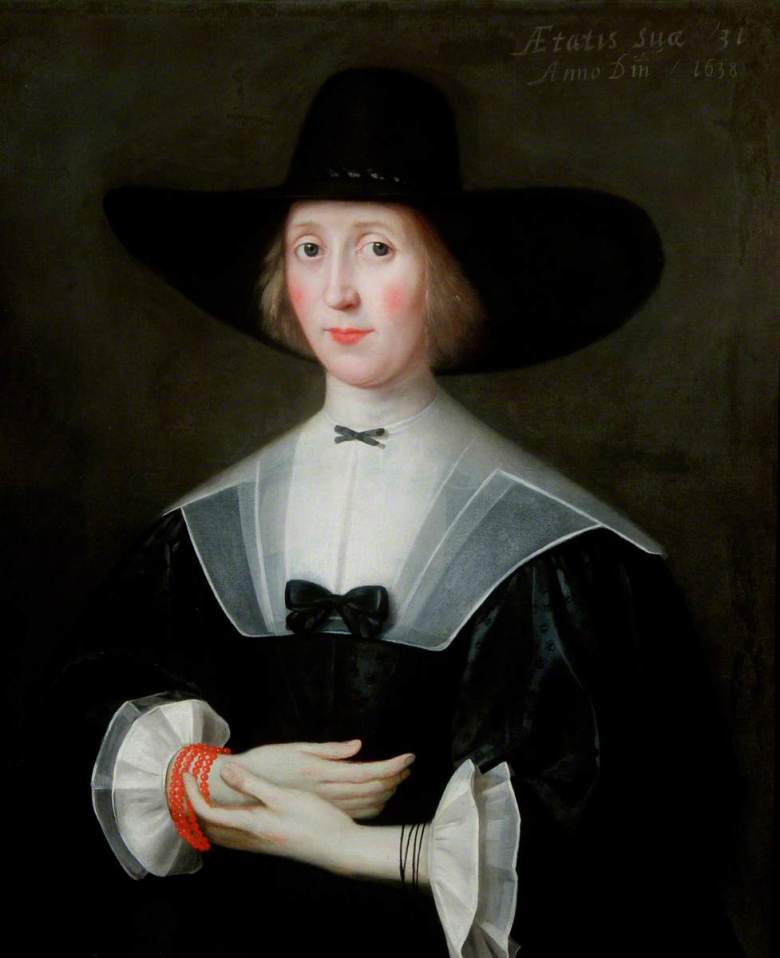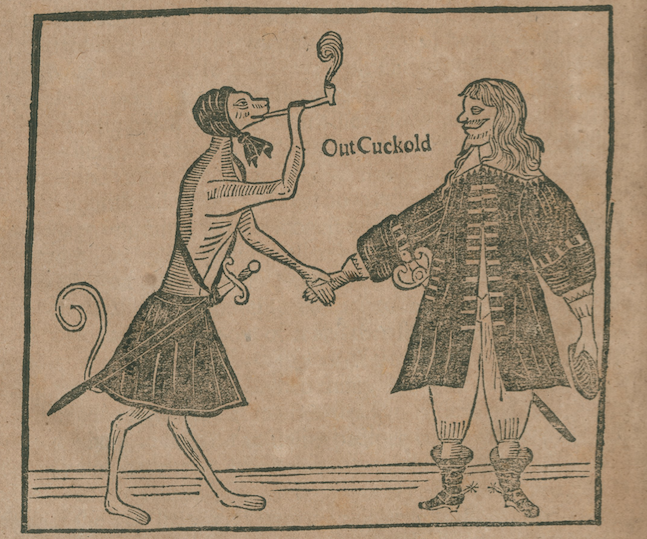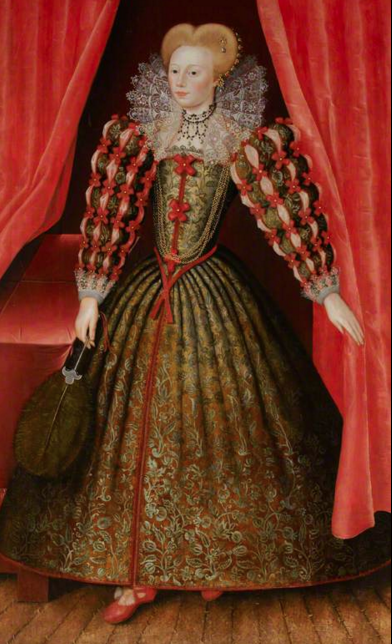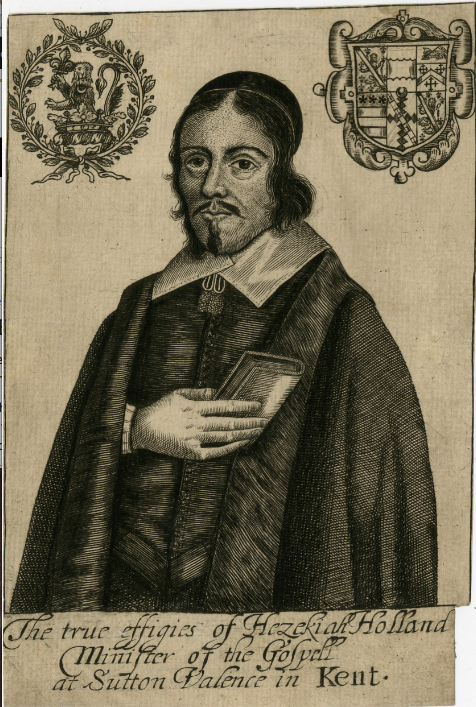February 10, 2017

Another unnamed portrait by an unnamed artist, this time in the Berwick Museum and Art Gallery. The canvas is dated 1638 and the title it’s been given says she’s a puritan. This was the catch all title for the collection of independent protestant sects, all slightly different from the next that grew up in the first half of the seventeenth century and exploded during the turmoil caused by the war. However she could just as easily be a member of a more established church group, or even a (gasp) catholic, there’s no way to tell from what she’s wearing how she worshipped.
The fine details show her double layer linen cuffs and the layers of fine see-through linen that comprise her neck covering. It’s up for debate, but around this time it could have been called a kerchief or a partlet. Both terms were in use, we just don’t know what (if any) distinction there was between the two. The layers however are so thin that you can see her smock beneath the fabric. The details of her bodice (or maybe waistcoat) are tricky to see as it has been painted so blackly there are no details. She has a coral bracelet on her wrist. These were worn as good luck charms and also were thought to have healing properties. Her hair seems to be undressed. but she has covered it with a magnificent broad brimmed hat.
Posted in Women |
Leave a Comment »
November 17, 2015
of Prince Roberts malignant she-monkey, discovered to the world before her marriage. Also the manner of her marriage to a cavaleer and how within three dayes space, she called him cuckold to his face, London 1643
One of those anti-royalist pamphlets referring to Prince Rupert’s selection of pets. His poodle Boye was also the subject of some derision but here is his monkey, presumably about the blow smoke cheekily in the face of her cuckolded husband.
She is wearing a hood tied beneath her chin, a short petticoat effort hiding her simian modesty (this is not standard 1640s fashion as far as I can tell) and a shoulder belt for her sword. The cavalier is wearing a long buttoned coat with turn back sleeves over a short doublet and tapered breeches. His linen band is smart with a modest lace edge and his riding boots (spot the spurs) are folded in the common style to show off his boot hose.

Posted in Uncategorized, Upper class |
Leave a Comment »
November 16, 2015
And an unknown boy, painted by an unknown artist around 1638-41. Dorothy, or more correctly Dame Dorothy may or may not have been Lady in Waiting to Elizabeth I in her youth and was also rumoured to have played a part in foiling the Gunpowder Plot, though later investigation revealed that her part was choosing the story as the subject of a tapestry that she made after the event! Dorothy died in 1641 apparently from being pricked by an infected needle (though this may have been fabricated too to attract visitors to the Hall) shortly after this portrait was completed. A popular story has her body walled up and her ghost walking the corridors of Ightham Mote. Sadly also not true, the grand Dame was safely interred in the local churchyard, but why let the facts get in the way of a cracking story?
Anyway, this picture caught my eye because Dorothy is not dressed in the latest fashion unlike the rather sad little boy in pink stood next to her. She is wearing a black petticoat and bodice over which she seems to have a red partlet or (perhaps a sleeveless waistcoat) covering her body and a large starched ruff around her neck. She’s keeping her head warm with a black hood and possibly a lace coif underneath. The boy is in a fashionable pink suit; matching doublet (slashed sleeves to show his shirt), breeches (trimmed with ribbon) and short cloak with a laced linen falling band and cuffs with matching ribbons on his shoes and pink hose.

Dorothy was some looker, forty years earlier. Both paintings are at Ightham Mote House in Kent.

M
Posted in Children, Uncategorized, Upper class, Women |
5 Comments »
February 3, 2015
Painted by a follower of Gilbert Jackson in 1634. This unnamed dapper gentleman of 30 is looking at us with a real ‘devil may care’ gaze, with his hand securely in the pocket of his breeches, an unusual stance in a painting from this date. He is wearing a neatly tailored grey doublet. If the painter’s depiction is accurate, this is a well made garment with sharp lines and very neat seams. The sleeve seams are open to display his shirt and ribbon points around his waist presumably hold his breeches up, though at this point, cord points were becoming decorative. The attachment to the breeches was more often than not achieved with metal hooks and eyes with the eyes being sewn to a girdle-stead fixed inside the doublet. He’s also wearing a plain-ish wide falling band with a narrow lace decoration (with matching cuffs) and pom pom decoration on his bandstrings. Nice row of closely spaced buttons down the front. The picture is in the Chequers Collection.
Posted in Upper class |
Leave a Comment »
February 27, 2014
Minister of the Gospell at Sutton Valance in Kent. This is the frontispiece from his tome entitled An exposition, or, A short, but full, plaine, and perfect epitome of the most choice commentaries upon the Revelation of Saint John, published in 1650. Amongst other bombshells, the book revealed that the end of the world was 216 years away. A comforting result for Hezekiah, but not so much for us. The Reverend Holland was originally from Ireland and an independent cleric who had been appointed a living by Parliament when the previous incumbent Robert Smith was ousted for his Royalist leanings.
The engraving shows a few quirky details, not least the overlarge hand emerging from the folds of his gown holding a book and the odd way his plain falling band corners cross over. Perhaps this is a bit more true to life than the perfect versions we usually see. It gives the minister a bit more character I think. He is also wearing a plain black day cap and a short tabbed doublet of the kind that had been generally worn, but had not been the height of fashion, since the 1630s at least. The tassels on his band strings are nice too.

Posted in Clerical |
Leave a Comment »
February 24, 2014
Engraved by Hollar and used as the frontispiece to The antiquities of Warwickshire illustrated from records, leiger-books, manuscripts, charters, evidences, tombes, and armes : beautified with maps, prospects and portraitures first published in 1656.
Sir William was an antiquary famed for his work recording church monuments, inscriptions and coats of arms which he undertook in the hope that they could be recorded before they were destroyed during the war. He also acted as King’s herald at Edgehill and in the summoning of Banbury, Warwick and Coventry to submit to royal authority.
Here he is seated amongst his books dressed in a long, fur lined coat with furred cuffs on the sleeves over a doublet, wide brimmed hat and breeches. He has double ruffs on his shirt sleeves and a decorative tassel on his band strings.

Posted in Upper class |
Leave a Comment »
February 4, 2014
Painted by an unknown artist shortly after 1650, this is a study of Charles and his Secretary at War Edmund Walker, ostensibly on campaign. The poses are staged in a tableau of Charles dictating a despatch, or maybe a proclamation to go to the printers. It’s such a static scene that it almost looks like a wax work, though notice all the subtle differences, not just in the poses, but also the clothes they are wearing that mark Charles out as the leader and Sir Edmund as the follower
Both men are wearing the blue ribbon as members of the Order of the Garter. They are both also oddly colour coordinated with each other, wearing blue doublet and breeches embroidered with gold thread, though the King’s doublet is more finely figured. Their buff coats match, though again Charles’s is more highly decorated. Edmund’s linen is plain whilst the King’s is edged with lace. He is also sporting a gilded breastplate. The picture hangs in the NPG in London and is © National Portrait Gallery.

Posted in Military, Upper class |
Leave a Comment »
January 16, 2014
Communicating many strange wonders, out of the world in the moon, the Antipodes, Maggy-land, Tenebris, Fary-land, Green-land, and other adjacent countries; published for the rightunderstanding of all the mad-merry-people of Great-Bedlam. One of those “believe it or not” publications, still popular today that was published periodically in the 1650s. This edition is from February 1654 and the picture shows a ghost that was seen in Smithfield by the local butchers, dressed in the clothes of a Lawyer called Mallet: pulling the meat off the Butchers Tainters; many have adventured to strike at him with Cleavers and Chopping-Knives, but cannot feel anything but Ayre,
Here is the ghost in a short tabbed doublet and breeches, falling band and an odd kind of bonnet, over which garb he is wearing a lawyer’s gown. He also has high heeled shoes over which have been stuffed what look like ram’s horns, possibly to mark him out as a ghost. Usually ghosts are depicted in their winding sheets.

Posted in Upper class |
1 Comment »
January 6, 2014
Painted by Cornelius Janssens van Ceulen in the 1630s, Elizabeth was wife to Sir Thomas, first Baron Coventry who was a career lawyer and involved in several high profile legal cases through the years before the wars, though treading a politic central line between the King and parliament, he managed to keep his position for many years.
Elizabeth is wearing a black dress, presumably bodice and petticoat skirt, though it is tricky to see any details, a black coif on her head, with a triple-layered kerchief around her neck and matching lace on her cuffs.
The painting is in the collection of the Sheffield Museums

Posted in Upper class, Women |
Leave a Comment »
November 29, 2013
This picture came up for sale at Christies in London in 2011, and is described as “Family portrait, small three-quarter-length, in black, red and white dress”. It has scant provenance, and in fact is inscribed on the frame with a story of how it turned up: ‘This oil painting washed ashore at Rottingdean with other wreckage from the Australian ship “Simla”,: Run down by the ship City of Lucknow, Feb 25th 1884’. It’s a lovely picture of a typical family from the seventeenth century and has the look of those Dutch master paintings of ordinary folk that hardly ever turn up in portraits by English artists
The people in the picture are dressed in clothes that place the time of the picture in the 1640s or thereabouts, and seem to be as described, a family group. They mostly look at us from the picture, though the three figures on the right look across the picture at the eldest member of the family. He is presumably the grandfather of the family and is dressed in a gown and ruff collar with a lace edged day cap. The husband and wife (I imagine) are in their best blacks. The wife with a neat plain layered kerchief and a black hood over hers (perhaps this refers to a lost child), whilst the man of the house is in a plain black doublet and a neat falling band. If you look closely though, he has left the lower buttons unfastened so you can see his shirt. The three children are all dressed in petticoats and aprons and there is no way to tell if they are boys or girls from what they are wearing. The seventh figure is partly hidden by an open door and seems to be wearing a red waistcoat over petticoat skirts and an apron and kerchief.

Posted in Children, servants, Upper class, Women |
Leave a Comment »










